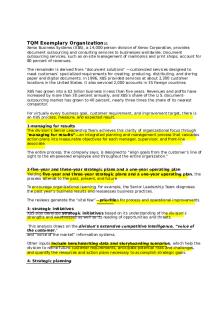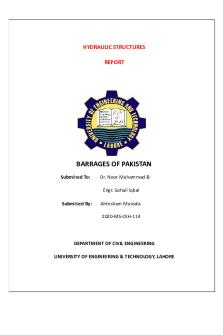Bangladesh and Pakistan case study summary PDF

| Title | Bangladesh and Pakistan case study summary |
|---|---|
| Author | Sapna VK |
| Course | development economics |
| Institution | Sindh Madressatul Islam University |
| Pages | 4 |
| File Size | 143.6 KB |
| File Type | |
| Total Downloads | 36 |
| Total Views | 150 |
Summary
Bangladesh and Pakistan case study summary. It is about the beginning years of independence. How they came through the challenges at different areas....
Description
o NAME:
SAPNA V KHEMANI
o ID:
BUS-18F-085
o DEPARTMENT:
BUSINESS ADMINISTRATION
o SECTION:
B
o SEMESTER:
VI
o DATE:
8-MARCH-2021
o SUBMITTED TO:
MA’AM SAHAR CHANNA
CASE STUDY “CAMPARATIVE ECONOMIC DEVELOPMENT: PAKISTAN AND BANGLADESH” Bangladesh got independence from Pakistan in 1971. Both Bangladesh and Pakistan are low income countries. William Easterly declared Pakistan as “Growth without Development” with low social indicators for its income and growth. Bangladesh was being transformed from a famine state towards hope. GROWTH In comparison with Bangladesh, Pakistan’s average income is higher. From 1950-2000, Pakistan’s per capita income grew 2.2% which is tripled. Pakistan’s per capita growth was 3.1% and population growth of 6%, was averaged 4.9% from 2000-2011. Bangladesh had an averaged GDP growth of 6% with 1.3% Population growth and 4.7% per capita GDP growth in 20002011. Bangladesh faced huge crises when international textile quota of multifiber was closed in 2005, but now they are recovering from it. POVERTY The population that lives under the poverty line in Pakistan is 1.25% and 51% in Bangladesh. In Bangladesh income of poor people are increasing due to the fact the some factors like NGOs working in the rural areas are trying to eradicate extreme poverty, opportunities for women in industries, and giving remittances for relatives who live abroad. Bangladesh remains the poorer country than Pakistan as 80% of their population are living under 2$ per day, while Pakistan has 6.1% of this ratio. EDUCATION AND LITERACY The literacy rate in Pakistan for female was 40% and 60% for male as explained by UNISECO in 2011. While in Bangladesh the literacy rate for female was 53% and was 62% for males. In the years 2011, enrollment in schools of students was 52% in Bangladesh and 35% in Pakistan. The enrollment ratio for primary and secondary students of female to male was 1.07% to 1% in Bangladesh and only 0.83% in Pakistan. Ishrat Hussain believed that poor population of Pakistan 1
were not able to get basic education because of the elite group was not letting them to. BRAC helped both the nations in the sector of education and now both the countries are progressing. HEALTH In 2012, the difference in life expectancy between Pakistan and Bangladesh is of 4 years; 65 years in Pakistan and 69 years in Bangladesh. But in 1970 the life expectancy rate was 54 years in Pakistan and 44 years in Bangladesh. The under-5 mortality rate has fallen drastically in Bangladesh and also the child malnutrition rate has also fallen from two third to half. In the year 1970, under 5 mortality rate in Bangladesh was 239/1000 and 180/1000 in Pakistan. POPULATION At the time of independence every women in Bangladesh gave birth to 6 children but they have progressed in reducing the fertility rate to 2.2%. While in Pakistan the fertility rate has fallen about 3.3%. Fertility rate have fallen due to the increase in progress economically and socially. These lower fertility rates help in more investment in our children. UNDERSANDING THE DIVERGENCE It is important to know about the unexpected poor performance of Pakistan in social development and in recent growth. In relation with Bangladesh what we can do to improve our condition. GEOGRAPHY Geography has the development success which Bangladesh lacks because it is a tropical country. 1174 people are living in Bangladesh. Hence it is a densely populated country. 98% of its population is ethnic Bangla and speak Bangla language while Pakistan has diversity in level of ethnicity and in languages. GENDER EQUALITY In 2013, the gender equality index was 0.55% as compared with 0.29% of Pakistan. In 2008, the literacy rate of males and females in Pakistan was 60% and 83% in Bangladesh. And there are more working opportunities for women in garment factories. 2
AID Pakistan is considered as the top earning countries as it has received great aid since it got independence. But after the attack in September 11th in USA, Pakistan became their ally. Due to the active involvement of Bangladesh in NGOs, they have also benefited from aids. GOVERNANCE AND ROLE OF MILITARY Politics have been always been playing a leading and prominent role in Pakistan. Due to the Kashmir issue, most of Pakistan’s budget goes to military because of the chance of having war with India. The elections of 2013 were considered highly fair representing democracy. The military was very active in Bangladeshi politics after the independence but the withdrawal of military from politics in 1990 was the reason for their progress. CIVIL SOCIETY Civil society is also known as non-government or citizen sector. Bangladesh has one of the most liberal NGOs in the world. Ishrat Hussain had announced that the main reason behind Pakistan’s bad governance was domination of political power for seeking to advance family interests called the “Elitist growth model.” The lower the literacy rate remains, lower will be the chances to replace the elites. CONCLUDING REMARKS Bangladesh’s and Pakistan’s social development is not overwhelming as it would be with comparison with Sri Lanka, which had its favorable human development statistics for its low income level in spite of the long lasting civil conflict. But overall Pakistan’s growth is much higher than other countries in terms of social improvements, health, education, and has done a lot with the available aids. The long-term trends are slower in Pakistan and higher in Bangladesh. The current development of these two countries is not much different.
3...
Similar Free PDFs

Case study summary
- 2 Pages

Discharge Summary - Case Study
- 2 Pages

Barrages of Pakistan detail study
- 17 Pages

Case summary and formulas
- 8 Pages

Tesco-Case-Study - Case Study
- 3 Pages
Popular Institutions
- Tinajero National High School - Annex
- Politeknik Caltex Riau
- Yokohama City University
- SGT University
- University of Al-Qadisiyah
- Divine Word College of Vigan
- Techniek College Rotterdam
- Universidade de Santiago
- Universiti Teknologi MARA Cawangan Johor Kampus Pasir Gudang
- Poltekkes Kemenkes Yogyakarta
- Baguio City National High School
- Colegio san marcos
- preparatoria uno
- Centro de Bachillerato Tecnológico Industrial y de Servicios No. 107
- Dalian Maritime University
- Quang Trung Secondary School
- Colegio Tecnológico en Informática
- Corporación Regional de Educación Superior
- Grupo CEDVA
- Dar Al Uloom University
- Centro de Estudios Preuniversitarios de la Universidad Nacional de Ingeniería
- 上智大学
- Aakash International School, Nuna Majara
- San Felipe Neri Catholic School
- Kang Chiao International School - New Taipei City
- Misamis Occidental National High School
- Institución Educativa Escuela Normal Juan Ladrilleros
- Kolehiyo ng Pantukan
- Batanes State College
- Instituto Continental
- Sekolah Menengah Kejuruan Kesehatan Kaltara (Tarakan)
- Colegio de La Inmaculada Concepcion - Cebu










